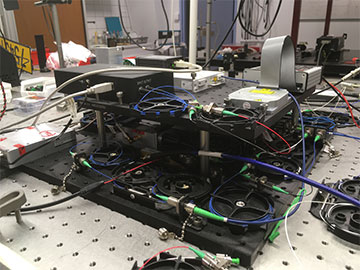
Researchers developed a new analog photonic correlator that can be used to locate an object transmitting a radio signal. The new correlator could be useful for locating cellphones, signal jammers or a variety of tracking tags. The photo shows the optical setup used for the research. [Image: H. Guillet de Chatellus, Université Grenoble Alpes–CNRS]
Photonics might not sound like the solution to radio-frequency (RF) correlation problems. But a trio of French physicists found the technology works faster than other methods for locating the sources of radio signals.
The team, based at the Université Grenoble Alpes–CNRS, France, has designed an analog photonic RF signal correlator from off-the-shelf telecommunications components (Optica, doi: 10.1364/OPTICA.442906). The device avoids both the complexity of wideband digital correlation and the low bandwidth of analog RF components.
Although the three scientists plan to apply the photonic correlator to astrophysical signals, they say the concept could be applied to terrestrial needs, from locating wayward cellphones to electronic warfare.
Calculating cross-correlation
The Grenoble team’s analog photonic correlator turns RF signals from a single source, but detected by two antennas, into optical signals and computes their cross-correlation function. After the computation, other processing equipment digitizes the results.
Central to the photonic correlator is a CW laser beam operating at a standard telecom frequency of 1550 nm. The laser light seeds a bidirectional fiber frequency-shifting loop, and the signal is amplitude-modulated by two RF signals. Through a variable optical delay line, users can control the relative time delay of the signals.
According to the lead author, Grenoble physicist Hugues Guillet de Chatellus, the most important part of the system is the frequency-shifting loop. “This simple photonic architecture has been at the heart of many recent progresses in microwave photonics,” from arbitrary signal synthesis to all-optical signal processing, he says.
Background and future
Guillet de Chatellus says he has been working on frequency-shifting loops for a long time. “In these systems, one is able to generate and to manipulate a large number of time-shifted replicas of an input signal,” he adds. “Thus, I had a vague idea of using the system for signal correlation.”
The work reported in Optica sprang from Guillet de Chatellus’ conversations with two colleagues from the Grenoble astronomy department, Guillaume Bourdarot and Jean-Philippe Berger, who became co-authors on the paper. Bourdarot and Berger are working on heterodyne interferometry, in which heterodyne mixing with a single-frequency laser converts the optical input signals collected at the telescopes to the RF domain. “However, they were aware that the correlation of RF signals by conventional digital means has intrinsic limitations (especially in terms of bandwidth and scalability),” Guillet de Chatellus says. “This is why they were interested in the capability of our analog photonic architecture.”
According to Guillet de Chatellus, the trio’s next step is to demonstrate the architecture’s ability to correlate three signals, which will enable the physicists to demonstrate three-dimensional localization of signal transmitters by triangulation. With other Grenoble astronomers, they will use the correlator to try to image the sun in the microwave 10-GHz band by interferometry. Eventually, they hope to integrate the photonic correlator into astronomical telescope arrays dedicated to optical long-baseline interferometry.
